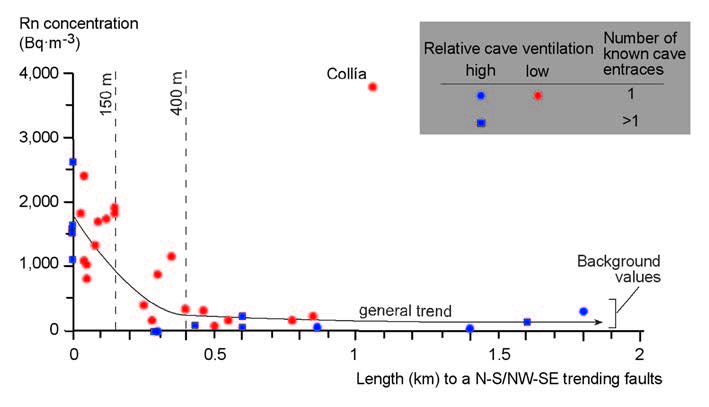Koncentracije radona v jamah kot kazalnik tektonske aktivnosti v Kantabrijskem gorovju (Španija)
DOI:
https://doi.org/10.3986/ac.v50i1.7795Ključne besede:
aktivni prelom, geokazalniki, kraška jama, radonPovzetek
Prenos radona iz globokih virov na površje velikokrat poteka vzdolž dobro prevodnih neotektonskih razpoklinskih struktur. Zato je povečana koncentracija radona na površju eden od potencialnih kazalnikov tektonske aktivnosti v nekem masivu. V raziskavi smo ugotavljali povezavo med koncentracijo radona v kraških jamah in tektonskimi strukturami v Kantabrijskem gorovju v severni Španiji. Zaradi tektonskega dvigovanja Kantabrijskega gorovja, so formacije močno razpokane, zato so povezave med globokimi viri radona in površjem zelo verjetne. Z detektorji CR-39 smo na 34 točkah izmerili povprečno koncentracijo radona v obdobju osmih mesecev. Meritve koncentracije radona so bile izvedene v 28 jamah v centralnem delu Kantabrijskega gorovja. Območje je pretežno iz sedimentnih in nizko metamorfoziranih kamnin z nizko vsebnostjo urana. Korelacijo med koncentracijo radona v jamah ter položajem tektonskih struktur smo določali z orodji geografskih informacijskih sistemov. Koncentracije radona nad 0,5 kBq·m-3 smo izmerili v jamah, ki so nastale ob tektonskih strukturah v smeri sever-zahod. Med temi smo koncentracijo nad 0,8 kBq·m-3 izmerili v jamah, ki so v bližini (< 200 ± 50 m) subvertikalnih prelomov. Visoke koncentracije radona kažejo na dobro razpoklinsko povezanost masiva, ki jo v najmlajših strukturah Kantabrijskega gorovja vzdržujejo subvertikalni prelomi v smeri sever-zahod. Študija je pokazala, da je na območju raziskave majhno, a značilno tveganje povečane radioaktivnosti v povezavi s prelomnimi in razpoklinskimi conami. V nasprotju s tem je v drugih tektonsko aktivnih okoljih radioaktivno tveganje povezano s premiki aktivnih prelomov.
Prenosi

Prenosi
Objavljeno
Kako citirati
Številka
Rubrike
Licenca

To delo je licencirano pod Creative Commons Priznanje avtorstva-Nekomercialno-Brez predelav 4.0 mednarodno licenco.
Avtorji jamčijo, da je delo njihova avtorska stvaritev, da v njem niso kršene avtorske pravice tretjih oseb ali kake druge pravice. V primeru zahtevkov tretjih oseb se avtorji zavezujejo, da bodo varovali interese založnika ter da bodo povrnili morebitno škodo.
Podrobneje v rubriki: Prispevki




